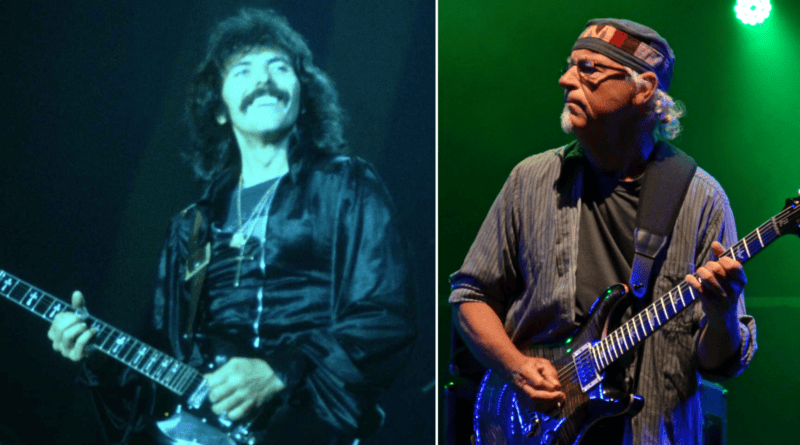Although he’s almost synonymous with the legendary prog rock band, guitarist Martin Barre recalled that he didn’t exactly leave the best impression on Ian Anderson, the band’s frontman and leader. And, at that same audition, as he told VRP Rocks in an interview, was also Black Sabbath’s Tony Iommi who ended up getting the gig.
As we all know by now, Iommi stayed for a little while, only to return to his band, with Barre adding that Jethro Tull’s music simply didn’t suit the Black Sabbath guitarist. The whole story came up when Barre was asked to share his story on how he ended up joining Jethro Tull in the first place.
“It was a complex run up to it because me and Ian were the only two guys in England playing flute in the Roland Kirk style,” said Barre while looking back at the 1960s. “So we sort of knew of each other through the grapevine but had never heard each other and never met. So this was sort of going on, and you’d hear, ‘Oh, I went see that guy who plays flute like you.’ And he was probably getting the same his direction.”
Barre’s flute-playing skills are what helped him achieve this first contact with Ian Anderson. Although it took a while for them to actually meet, the first impressions seemed to have been in perfect order. Looking at the first gig that Jethro Tull and Barre’s band Gethsemane did together, he offered:
“And finally, we played in Plymouth, which is where I live, near Plymouth — the Van Dike Club. It was the opening night at the Van Dike Club, which is an amazing place where they had pretty much every band from the UK — Cream, John Mayall, The Who, Pink Floyd… It was like the Marquee [Club], but it was here in Plymouth.”
“So this is the opening night and it was Jethro Tull headlining and Gethsemane — my band — supporting. So it was the big meeting we’ve been waiting for, for all these months. And we got on great and we talked about the flute we both played in, obviously, very similar style. So I was playing flute and guitar. And my band was a blues band.”
Despite the similarities in their flute-playing style, Barre was considered as a guitar player when Jethro Tull parted ways with their original axeman Mick Abrahams:
“So a few months later, Mick quits Jethro Tull, they’re looking for a guitar player,” Recalled Barre. “They’re trying to think who they know.”
But things weren’t that simple back then since — obviously — they didn’t have the internet and social media back in the late 1960s:
“They remember me but they can’t remember my name or the band I was playing in. So in the end, Terry Ellis, the manager of from Chrysalis records family, and he found me…”
The timing was perfect since Barre’s band was just about to quit:
“We were quitting because we were just making no money for three years, and we were finally gonna call it a day. The very last gig, we were in London, and he found me. Gave me his card to call [him].”
Funnily enough, Martin knew that they were looking for a new guitar player but was too hesitant to respond to the ad in the Melody Maker magazine:
“I was too scared to apply. I didn’t have the confidence. So there was the card, I called him in the morning, [went to] audition for the guys and I turned up in SoHo in his basement room.”
But Barre’s personality wasn’t exactly compatible with the scene:
“And the whole room is lined with guitar players. All the way around the wall with Clive [Bunker, drummer] and Glenn [Cornick, bassist] in the middle, playing, jamming. Each [guitar player] would come up and jam. When Ian had enough, he’d tap Clive on the shoulder, and they’d stop and go ‘Thank you, next.'”
That does sound like a pressure-inducing setting. And Martin’s performance suffered:
“It was hideous,” the guitarist said. “I didn’t fall apart, but I was rubbish. I was so bad playing guitar. I said, ‘Should I play a bit of flute?’ [Laughs] I don’t know why I said it. So I played some piece that I knew on flute and that was really good. But that was no use.”
In the end, as Martin recalls, he managed to get on the shortlist but he lost the spot to the guy who would become known as The Riff Lord. “They went for Tony,” he offered, but then also added that this wasn’t exactly a match made in heaven:
“Tony didn’t particularly meld with the music — didn’t suit him. He wasn’t comfortable.”
“And at the same time, I just thought I’d call Ian say, ‘Look, it was dreadful, I played really badly. What’s going on?’ Because, you know, if there’s another chance, I had jumped at it. There was — we had a rehearsal in The Angel, Islington, in a pub, all day. I learned a bit of their music, they learned a bit of mine. And, there you go!”
Iommi would go back to Black Sabbath only weeks after joining Jethro Tull. There were only two public performances Iommi had with Ian Anderson’s band, one of which was mimed in front of cameras for “The Rolling Stones Rock & Roll Circus” back in 1968.
Despite the disastrous audition, Barre joined the band. As the guitar legend added, he just knew that the gig was right for him:
“Something in me — I knew that that was the gig. My gig. And I don’t know why, because I was a very shy and not very confident musician. But I just knew it was meant to be.”
Photos: Kergourlay (Pat O’May Festival de la Saint-Loup 16), Carl Lender (Tony Iommi at the New Haven Coliseum)


